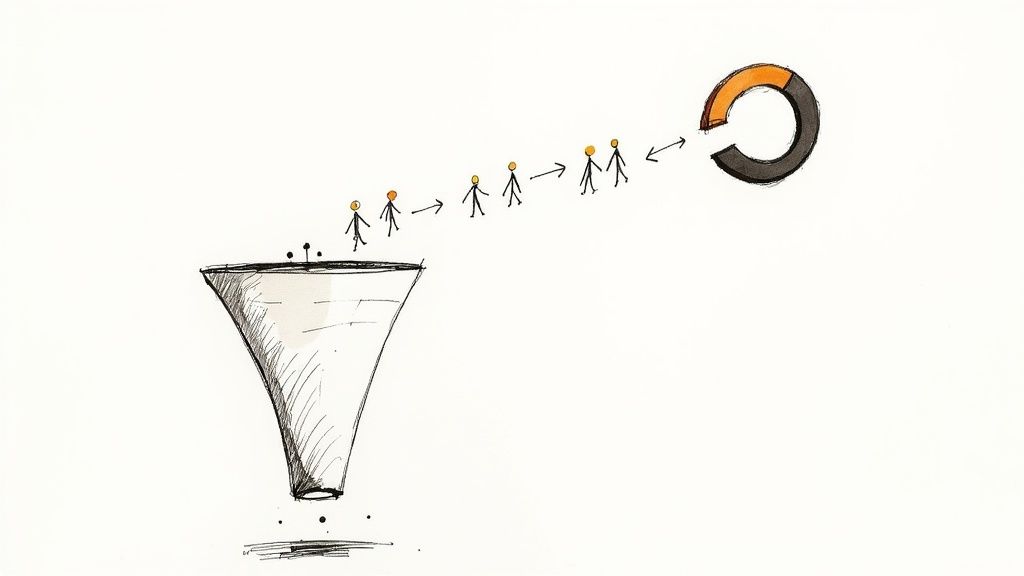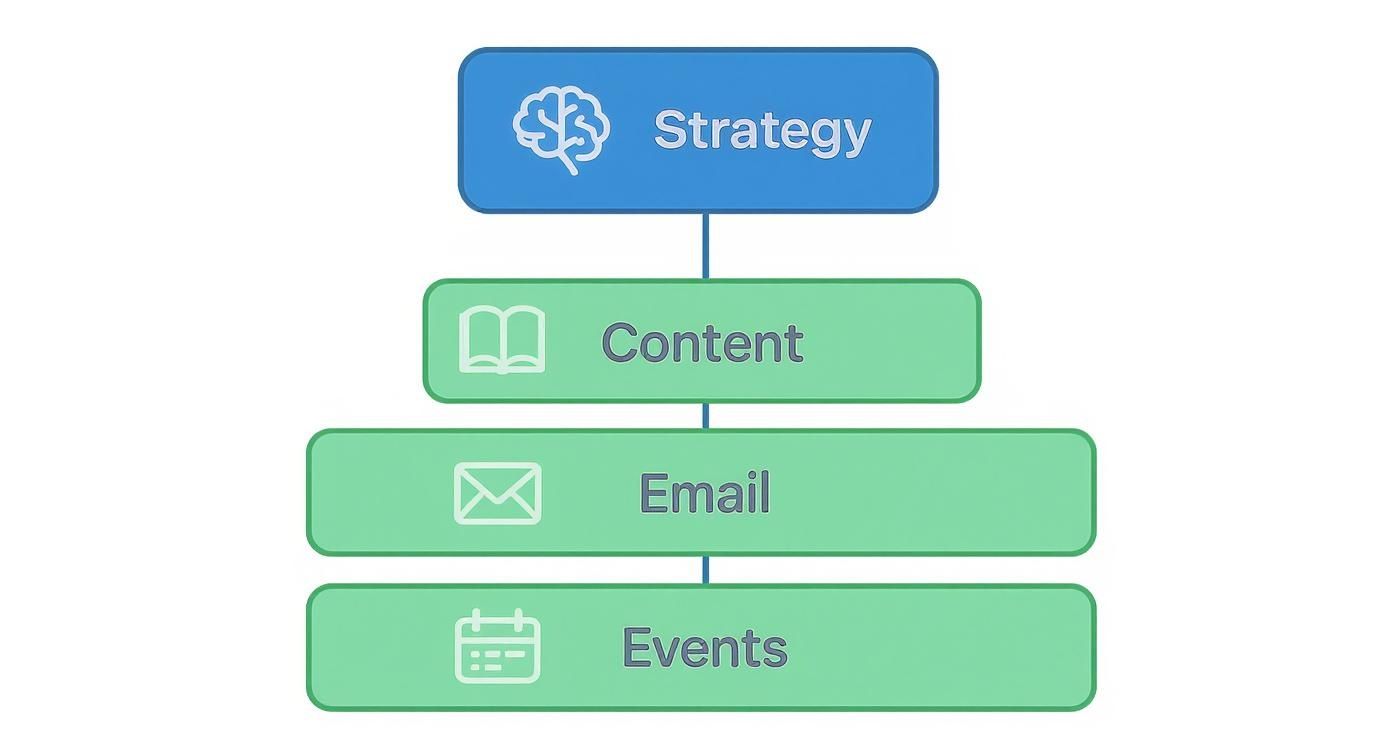October 28, 2025

So, what exactly is lead generation?
At its simplest, it’s the process of sparking interest in what your business offers. You're not just shouting into the void; you're creating a magnetic pull that draws potential customers in, building a pipeline of people who might actually want to buy from you.
Think of it less like a cold call and more like starting a great conversation at a networking event. It’s the first—and most crucial—step in turning a complete stranger into someone genuinely curious about your brand.

Lead generation is all about warming up potential customers and gently guiding them toward a purchase. Instead of interrupting people who've never heard of you, you're connecting with those who have already shown some sign of interest.
A lead isn't just a random name on a list. It's a person or a company that has signaled they're open to hearing from you, usually by sharing their contact information, like an email address. The "generation" part is all about the marketing magic you use to attract them and capture that initial interest.
This isn't just a "nice-to-have" strategy; it's the engine for sustainable business growth. And marketers everywhere agree on its importance.
A recent survey found that 91% of marketers see lead generation as their single most important goal. It’s so critical, in fact, that over half of them dedicate at least 50% of their entire marketing budget to it. You can dig into more stats in this detailed lead generation report.
The whole point is to make the journey from stranger to customer feel natural and valuable. You offer something genuinely useful—a helpful guide, a free webinar, an insightful newsletter—and in return, you earn their permission to stay in touch. This builds a foundation of trust right from the very first hello.
Of course, putting these ideas into action requires the right tech. This is where choosing from the best lead generation tools becomes a game-changing decision for any growing team.
To help you get a handle on the language, here's a quick-reference table to demystify the core terms you'll encounter on your lead generation journey.
This table is just a starting point. As you dive deeper, you'll see how these concepts interlock to create a powerful system for attracting and converting new business.

Think of a business without a steady flow of new leads. It’s like a car trying to run on fumes—it’s not going to get very far. Lead generation isn't just another marketing buzzword; it’s the engine that powers sustainable growth and keeps your sales pipeline humming.
It’s the difference between hoping for new customers and having a reliable system for attracting them. You stop waiting for people to find you and start actively building a community of prospects who are genuinely interested in what you have to offer.
At its core, lead generation connects your marketing work directly to the bottom line. It’s not just about collecting contact information. It’s about creating real opportunities that drive revenue and expand your footprint in the market.
This process also teaches you a ton about your audience. Every new lead is a data point, giving you insights into who your customers are and what they actually need. You can then use that knowledge to sharpen your messaging and refine your offers.
A predictable flow of leads gives your sales team the fuel they need to consistently hit their targets. Suddenly, growth isn't a guessing game anymore—it's a calculated, repeatable process.
When you have this kind of system in place, you can grow with intention. For anyone serious about expansion, mastering scaling with systems becomes the logical next step.
A well-oiled lead generation machine delivers some major wins:
When you're trying to start a conversation with potential customers, you've really got two main paths to choose from: inbound and outbound. Getting the difference between them is the first step in building a strategy that actually works for your business.
I like to think of it as a magnet versus a megaphone.
Inbound lead generation is all about being the magnet. It’s a philosophy centered on creating genuinely useful content that naturally draws people in—people who are already looking for answers to problems you can solve.
Instead of interrupting someone’s day, you’re offering value right from the start. This builds a foundation of trust and quietly positions you as a go-to expert in your field.
The big idea with inbound is to earn attention, not demand it. You create something so helpful that your ideal customers find you on their own terms, making them far more open to what you have to say.
This strategy is a long game. It's about building lasting relationships and a strong brand reputation by being there the moment someone needs you.
So, how do you make this happen? Common inbound methods include:
Now for the other side of the coin. Outbound lead generation is your megaphone. This approach involves you proactively reaching out to a list of potential customers, whether they've heard of you or not. You’re pushing your message out to a specific audience.
Outbound can get you results much faster, but let's be honest, it can also feel more intrusive if not done well. The key to successful outbound is razor-sharp targeting. You have to be sure your message is landing in front of people who are very likely to be interested. It’s perfect for reaching specific decision-makers or breaking into a new market.
Some go-to outbound strategies are:
To really see the difference, it helps to put them side-by-side. This table breaks down the core distinctions between the two approaches.
Ultimately, you don’t have to choose just one. The smartest businesses find a way to blend both. They might use outbound tactics to get a foot in the door and then use inbound content to build that initial spark into a lasting customer relationship.
Alright, so we've covered what lead generation is. Now, let's get into the fun part: making it happen. You need a solid game plan, and that means using the right tactics to find people who are genuinely interested in what you do.
Think of it like fishing. You wouldn't use a giant net designed for the open ocean to catch a specific type of fish in a small stream. You need the right gear for the right spot. The same goes for lead generation—your strategy has to match your brand, your audience, and what you’re trying to achieve.
To keep a steady flow of potential customers coming in, the smartest companies don't put all their eggs in one basket. They mix and match a few key methods that work together, creating a system that’s much stronger than any single channel on its own.
Here are a few of the most reliable strategies out there:
While content and SEO are fantastic, sometimes you need a more direct, personal connection. This is where channels like virtual events and social media really shine. A great webinar or a well-run social media campaign can build community and trust in a way that a blog post can't. For a deep dive into how this plays out in a specific industry, check out this excellent modern construction lead generation guide.
The numbers back up this multi-channel approach. Email is still a B2B powerhouse, with 78% of companies using it to generate leads. But hot on its heels are events and webinars, which 73% of organizations rely on. And right behind that, 67% use content marketing to draw people in.
The real magic happens when you stop thinking about these as separate channels. A great strategy connects them. For example, you write a compelling blog post (Content), promote it with an email campaign, and use it to drive sign-ups for a live webinar (Events). Suddenly, you’ve created a powerful system for generating high-quality leads.
And this isn't just for digital. When you're at a physical event like a trade show, the goal is exactly the same. The key is mastering that in-person engagement, which is why a seamless process for trade show lead capture is non-negotiable if you want to see a return on your investment. Every single conversation, whether it happens online or face-to-face, is a chance to move someone one step closer to becoming a loyal customer.
The path from a curious visitor to a hot lead isn't accidental. It's a carefully designed journey we call the lead generation funnel. Think of it like a real-world funnel you'd use in a kitchen: you start with a wide opening to pour in a lot of ingredients (your total audience) and it narrows down, guiding only the right stuff to the end point (a qualified lead).
This process is all about building a relationship. Understanding what lead generation truly is means knowing how to match your message to where someone is on their journey. Get it right, and you seamlessly guide them from "just looking" to "ready to talk."
At the very top of the funnel, or TOFU, your main job is to get noticed by a wide audience. These folks are just starting to realize they have a problem or a need, but they aren't actively shopping for a fix yet. Forget the hard sell; this is about education and being helpful.
The content here should be light, accessible, and valuable. You're trying to answer their initial questions and build a bit of trust.
The goal is simple: make a great first impression and get on their radar.
This infographic shows how different marketing efforts like content, email, and events all work together to power this funnel.

You can see how a core strategy branches out into the specific tactics you use across different channels.
Once someone moves into the middle of the funnel (MOFU), they've put a name to their problem and are now actively researching solutions. Your relationship with them needs to get a little deeper. This is where you prove you're an expert who can help.
This is your chance to shine. People are comparing their options, so you need to provide more substantial content. Things like case studies, webinars, and in-depth guides show you have real-world experience and can deliver results.
At last, we reach the bottom of the funnel (BOFU). The people here are ready to buy. They've done their homework, narrowed down their choices, and are probably comparing you against a couple of competitors. Your messaging now needs to be sharp, persuasive, and crystal clear about why you're the best option.
It’s time to make a direct offer that pushes them over the finish line.
As you start to put these ideas into practice, you're going to have questions. It’s only natural. This FAQ section tackles some of the most common hurdles businesses face when they're getting the hang of lead generation. The goal here is to give you the practical know-how to handle the tricky parts and make smart decisions for your marketing.
This is the million-dollar question. A high-quality lead, or what we often call a "good" lead, is someone who looks a lot like your best customers. They have the exact problem your product or service solves, they're in a position to actually say "yes" to a purchase, and they have the budget to afford it.
But quality isn't just about a name and an email address—it's all about context. Think about it: a prospect who downloads your detailed pricing guide is showing way more intent than someone who just casually reads a blog post. That's why a lot of businesses use a process called lead scoring. It’s a system that automatically ranks leads based on who they are and what they do, which helps the sales team focus on the people most likely to buy, right now.
Quality over quantity is the golden rule here. You're always better off with a smaller, highly engaged list of perfect-fit prospects than a massive database of people who don't care. Focusing on quality means your sales team spends their time on conversations that actually lead somewhere.
Honestly, it depends entirely on the path you take. There’s no magic number because different methods work at different speeds.
Paid advertising, for example, can start bringing in leads almost immediately. But the catch is, the moment you turn off the ad spend, the leads stop. It's fast, but it requires a constant budget. On the flip side, inbound strategies like creating great content or working on your SEO are more of a long game. They build momentum over time, often taking 3-6 months to really hit their stride, but they create a sustainable asset for your business that keeps paying off for years.
The smartest approach? Usually, it's a mix of both. Use some short-term tactics to get things moving while your long-term efforts build up in the background.
This one trips a lot of people up, but the distinction is pretty simple when you think about it.
Imagine you're selling water in a desert. Demand generation is the art of making people realize just how thirsty they are. It’s about creating broad awareness and a general desire for a solution like yours, educating the market, and getting people excited long before they even consider buying.
Lead generation, on the other hand, is the act of walking up to those thirsty people, offering them a glass of water, and getting their name in exchange. It’s the specific, measurable action of capturing contact information from people who have raised their hand to say, "I'm interested."
To put it simply:
Ready to turn your community engagement into a powerful lead generation engine? GroupOS provides an all-in-one platform to manage events, memberships, and content, helping you capture and nurture high-quality leads effortlessly. Start your free trial today and see how it works!


